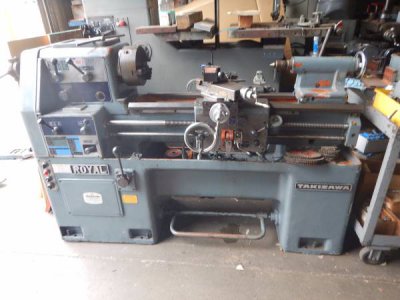Greetings,
I just joined the forum, but I'm not new to machine work. I recently swapped my 14X60 lathe to go to a "smaller" 14X32 (at a svelte 2500lbs). This little diamond in the rough, is a Takisawa TSL-800D imported by Webb in 1979. I have been surprised at how little discussion about these lathes exists. I spoke to Webb and they said they had imported 3500 of them until 1985. They were also imported by Yuasa and one or two other names and I have no idea how many more that accounts for. It's built like the proverbial brick outhouse and if I ever meet the engineer that drew up the plans, I'll kiss him! It is one of the most sensibly assembled machines and everything goes together logically for easy maintenance. The company got its start in Japan, but moved production to Taiwan in the 1970's.
As seems to be typical, this one was suffering from paint lifting from the underlying filler and casting, so since I hadn't any pressing need to put it into immediate service, I have torn it down for paint and maintenance. Once I got below 38 years of grime, I am finding all of the surfaces to be in extremely good shape with virtually no wear. What it lacked in cleaning was offset by being kept well lubricated. The only item I have yet found was a slight noise from the front bearing on the 5HP, two speed motor. A set of premium bearings set me back all of $59 with shipping and should be here today. I also have gotten three new panel switches as the originals look a bit hammered, however I found out current 30mm switches are a tad wider than the originals and a bit of cast iron will need to be trimmed back for clearance.
I am almost done with paint removal and will be reapplying body filler to keep the smooth finish. I had planned on a mundane coat of Battleship No.5 which I have in alkyd enamel, however, the evil squirrels told me I need to paint it Deutz Spring Green. I located a supplier that will ship some "evil" alkyd enamel industrial paint to earth conscious California. Oddly enough, you can purchase 3 one quart cans, but 1 gallon is banned (high capacity assault paint?) I have taken photos up to this point, but can't access them from this computer, so I will add some later.
If there are other Takisawa owners out there, chime in and say hello. I'm starting to think the lack of info about these lathes might be because they are new enough and stout enough to still be in active service with large facilities and not many have leaked into the hands of hobby/small shop environments. There are a few that turn up on Fleabay, but fairly uncommon. Even on the Practical Machinist forum there is little to be found, other than positive comments about them. So if you have one, let your presence be known and let's hear your story.
Mark


